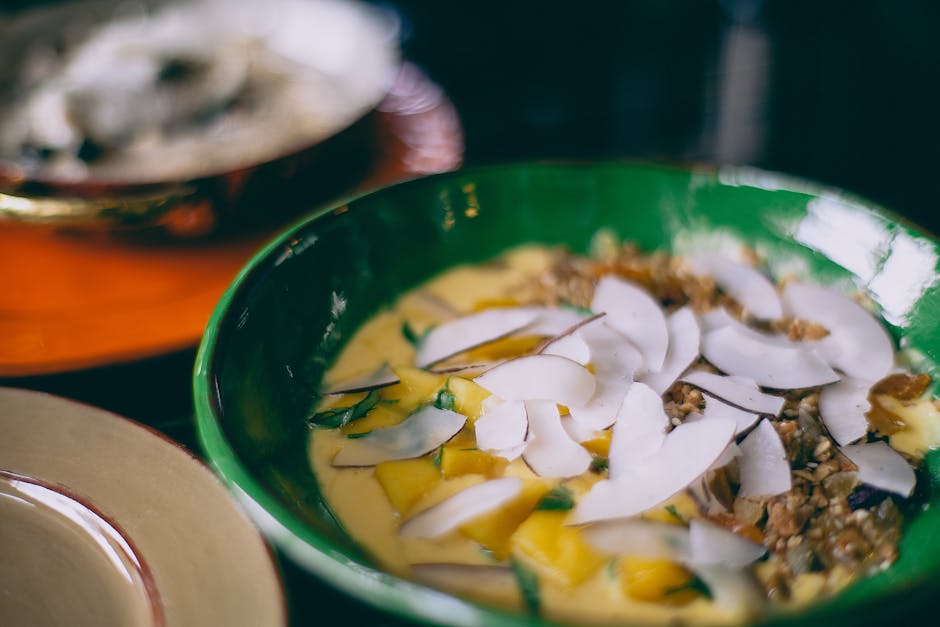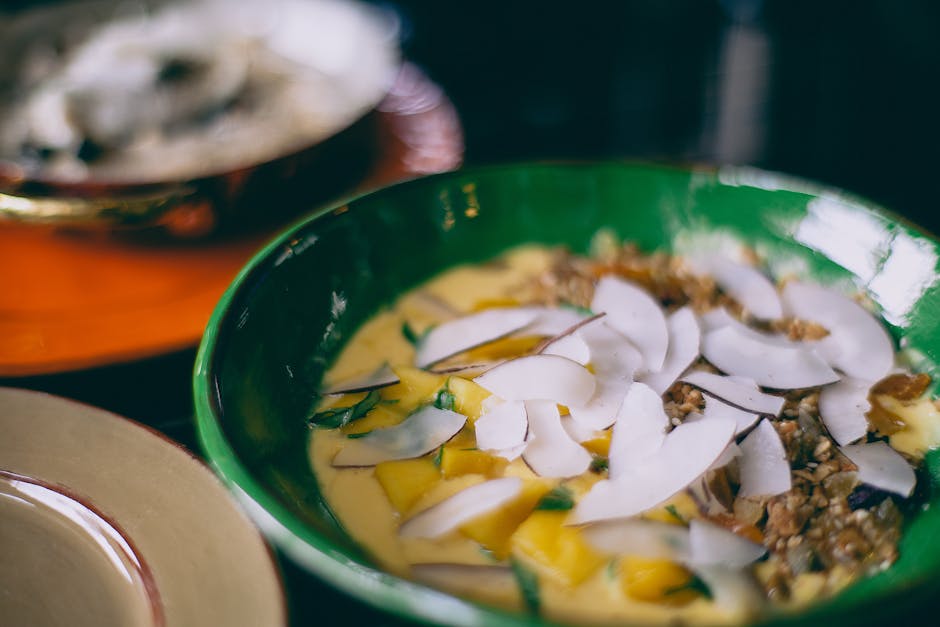Coconut mango pudding, a delightful dessert boasting a creamy texture and a vibrant tropical flavor profile, is a testament to the culinary fusion of diverse cultures. While pinpointing its exact origin is difficult, its components – coconut milk, mangoes, and the basic pudding structure – trace back to various parts of the world. Coconut milk’s usage is deeply rooted in Southeast Asian cuisine, where coconuts are a staple crop, featuring prominently in both sweet and savory dishes for centuries. Mangoes, on the other hand, have a rich history across South Asia and parts of the Pacific, with evidence suggesting cultivation dating back thousands of years. The pudding itself, as a culinary form, has evolved across numerous cultures, with variations appearing in Europe, the Americas, and Asia, indicating a long and diverse history of sweet, creamy desserts utilizing milk and thickening agents.
The specific combination of coconut and mango in a pudding format likely emerged in regions with abundant access to both ingredients, possibly in Southeast Asia. The Philippines, Indonesia, and Thailand, for example, all boast rich culinary traditions incorporating both coconuts and mangoes in various desserts. The exact timeline of its development remains speculative, but the relative ease of preparation and the naturally complementary flavors of coconut and mango likely contributed to its popularity. The dessert’s spread across the globe is facilitated by global trade and increased cultural exchange, leading to regional variations in recipes and presentation. For example, some versions might incorporate added sweeteners like sugar or honey, while others may use condensed milk for a richer, sweeter taste. Some recipes also include additions like tapioca pearls for added texture.
Beyond its deliciousness, coconut mango pudding holds cultural significance in many regions. In many Southeast Asian countries, it frequently appears at celebratory gatherings, festivals, and family meals. The vibrant colors of the dessert — the creamy white of the coconut milk contrasting with the sunny yellow-orange of the mango — are visually appealing and often symbolize joy and abundance. The sweet taste provides a comforting and celebratory element to these occasions. Furthermore, the ingredients themselves hold symbolic meaning in various cultures. The coconut, for example, is often associated with fertility and prosperity, while the mango symbolizes love and happiness. The global popularity of this dessert reflects a shared appreciation for simple, yet delicious, food that transcends geographical boundaries and cultural differences. Statistics show a significant rise in online searches for coconut mango pudding recipes, indicating a growing global interest in this tropical treat.
Ingredients and Measurements
This recipe for Coconut Mango Pudding yields approximately 6 servings. Accuracy in measurement is crucial for achieving the desired texture and flavor balance. We recommend using a kitchen scale for the most precise results, especially when measuring the cornstarch and sugar. However, if you don’t have a scale, careful use of measuring cups and spoons is acceptable. Remember to level off any dry ingredients after measuring.
For the Mango Puree:
- 2 ripe mangoes (about 1 pound total), peeled, pitted, and cubed: Choose mangoes that are fragrant and yield easily to gentle pressure. Overripe mangoes will provide a sweeter, more intense flavor, but be sure they are free of bruises.
- 2 tablespoons lime juice (freshly squeezed is best): Lime juice helps to prevent the mango from browning and adds a lovely brightness to the flavor.
For the Coconut Milk Mixture:
- 1 (13.5 ounce) can full-fat coconut milk: Using full-fat coconut milk is essential for achieving a rich and creamy pudding. Avoid using light coconut milk or coconut cream as they will not provide the same texture.
- 1 cup whole milk: Whole milk adds to the richness and creaminess of the pudding. You can substitute with 2% milk, but the texture might be slightly less rich.
- 1/2 cup granulated sugar: Adjust the sugar amount to your preference based on the sweetness of your mangoes. If using very sweet mangoes, you might reduce the sugar to 1/4 cup.
- 1/4 cup cornstarch: Cornstarch is the thickening agent for this pudding. Measure this accurately to achieve the desired consistency. Using a whisk to incorporate it into the milk mixture will prevent lumps.
- 1/4 teaspoon salt: A pinch of salt enhances the sweetness and balances the flavors of the pudding.
- 1 teaspoon vanilla extract: High-quality vanilla extract will significantly improve the overall flavor profile.
For Garnish (Optional):
- Fresh mango slices:
- Shredded coconut:
- Mint leaves:
Important Note: The cooking time for the pudding might vary slightly depending on your stovetop and the size of your saucepan. Keep a close eye on the pudding while it’s simmering and stir frequently to prevent scorching and ensure even thickening. The pudding is ready when it has thickened to a consistency similar to a thick custard. If it seems too thin, continue to simmer for a few more minutes, stirring constantly.
Professional Recommendation: For a smoother, lump-free pudding, strain the mango puree through a fine-mesh sieve before incorporating it into the coconut milk mixture. This will remove any fibers from the mango and result in a more elegant final product.
Equipment List for Coconut Mango Pudding
Creating a smooth and delicious coconut mango pudding requires the right tools. This equipment list details everything you’ll need, from preparation to presentation, ensuring a professional-looking and tasting result. We’ll cover essential items, helpful additions, and alternatives where possible. Remember, clean equipment is crucial for food safety and optimal flavor.
Measuring Tools: Accuracy is key in baking and dessert making. You’ll need at least one set of accurate measuring cups (dry and liquid) and measuring spoons. Invest in a good quality set for consistent results. Avoid using mismatched or worn-out measuring tools, as this can significantly impact the final texture and taste of your pudding. A kitchen scale is highly recommended, especially for measuring ingredients like coconut milk and sugar, ensuring precise measurements for optimal consistency.
Mixing and Blending: A high-powered blender is essential for achieving a perfectly smooth and creamy pudding. A standard blender will work, but a high-powered option will seamlessly blend the mango and coconut milk without leaving any chunks. A powerful blender minimizes the need for straining, saving you time and effort. If you don’t have a blender, a food processor can be a suitable alternative, but you may need to strain the mixture afterward to remove any larger fibers.
Cooking Utensils: You’ll need a medium-sized saucepan (approximately 2-quart capacity) for gently heating the coconut milk and sugar mixture. A sturdy whisk is necessary for smoothly combining the ingredients and preventing lumps from forming. A heatproof spatula or spoon will be helpful for scraping down the sides of the pan and ensuring even heating. Avoid using aluminum cookware, as it can react with acidic ingredients, potentially affecting the flavor and appearance of your pudding.
Serving and Storage: Once your pudding is ready, you’ll need individual serving dishes or a large bowl depending on your preference. Glass bowls or ramekins are ideal for showcasing the vibrant color of the pudding. If you’re making the pudding ahead of time, you’ll need airtight containers for refrigeration. Using airtight containers prevents the pudding from absorbing odors from other foods in the refrigerator and helps maintain its freshness. For a professional finish, consider using plastic wrap to cover the surface of the pudding to prevent a skin from forming.
Optional Equipment: To enhance your pudding’s presentation, consider using a piping bag and tips for creating decorative swirls on top. A fine-mesh sieve can be used to strain the mixture for an ultra-smooth texture, although a high-powered blender typically renders this unnecessary. A small bowl is useful for preparing any toppings separately. If you’re using fresh mangoes, a sharp knife and cutting board are essential for preparing the fruit. A citrus juicer can be helpful if you wish to add a touch of lime juice for extra zing.
Cleaning and Maintenance: After preparing your coconut mango pudding, promptly clean all your equipment. Washing and drying your equipment immediately prevents residue from drying and sticking, making cleanup much easier. Following the manufacturer’s instructions for cleaning your blender and other appliances is crucial for their longevity and proper functioning.
Preparation of Mango
The quality of your mangoes significantly impacts the final taste of your Coconut Mango Pudding. Therefore, selecting ripe, flavorful mangoes is the first crucial step. Aim for mangoes that are slightly soft to the touch, fragrant, and yield gently to pressure. Avoid mangoes that are bruised, overly hard, or have blemishes. For this recipe, we’ll need approximately 2 large ripe mangoes (about 1.5 pounds total), although you can adjust the quantity based on your preference for mango intensity.
Once you’ve selected your mangoes, the next step is to peel them. Using a sharp paring knife, carefully peel the skin away from the mango flesh. Avoid cutting into the flesh as much as possible to minimize waste. Work your way around the mango, removing the skin in long strips. If you encounter any particularly stubborn sections, you can use the tip of your knife to gently loosen the skin.
After peeling, we need to remove the mango flesh from the pit. There are several techniques you can employ. One method is to stand the mango upright on a cutting board and slice along each side of the pit, creating two large, curved pieces of mango. Then, you can use a knife to carefully slice away any remaining flesh clinging to the pit. Another method is to slice the mango into thin slices, and then, use a sharp knife to carefully cut the flesh away from the pit. Choose the method you find most comfortable and efficient.
Now, it’s time to dice the mango. The size of the dice is up to your preference, but for this recipe, we recommend dicing the mangoes into ½-inch cubes. This size is large enough to be noticeable in the pudding but small enough to ensure even distribution. Consistent sizing also contributes to a visually appealing final product. If you’re making a smoother pudding, you can choose smaller diced mangoes or even puree a portion of the mangoes for a creamier texture.
Once you have diced all of your mangoes, it’s a good idea to taste a piece to ensure they are perfectly ripe and sweet. If they lack sufficient sweetness, you may want to add a touch of sugar or honey to the pudding later on to balance the flavors. Remember, the natural sweetness of the mangoes will significantly influence the overall sweetness of the dessert, so adjusting accordingly is key.
Finally, before incorporating the diced mangoes into your coconut mango pudding, consider setting aside a small portion (about ¼ cup) of the diced mango. This reserved mango can be used as a garnish on top of the finished pudding, adding a visually appealing touch and enhancing the overall presentation. This small detail can elevate your dessert from good to exceptional.
Preparation of Coconut Milk
The quality of your coconut milk significantly impacts the texture and flavor of your Coconut Mango Pudding. Therefore, taking the time to prepare it properly is crucial. While you can certainly use canned coconut milk, making your own offers a fresher, richer flavor profile and allows for greater control over the consistency.
For this recipe, we’ll be making coconut milk from fresh coconuts. You will need approximately two mature coconuts, yielding roughly 2 cups of coconut milk. Selecting ripe coconuts is key; they should feel heavy for their size and have a brown husk. Avoid coconuts with cracks or soft spots.
To begin, carefully crack open the coconuts. Wear protective gloves to avoid sharp edges. You can achieve this by tapping the coconut firmly all around with a hammer until it cracks. Alternatively, you can use a coconut opener. Once cracked, carefully separate the shell halves. Use a sturdy spoon or a coconut scraper to scoop out the white coconut flesh, avoiding any brown spots or hard pieces. It is important to remove all the flesh; the yield of coconut milk depends on it.
Next, coarsely grate the coconut flesh using a box grater or a food processor. Ensure that the coconut is grated finely; this will maximize the extraction of coconut milk. If using a food processor, pulse in short bursts to avoid over-processing and creating coconut butter.
Now, we’ll extract the coconut milk. Add the grated coconut to a large bowl and pour in approximately 2 cups of hot water (not boiling). The water temperature is crucial; hot water helps extract more of the coconut’s creamy goodness. Stir well and ensure all the coconut is thoroughly saturated. Let the mixture sit for at least 15 minutes, or even longer for a richer milk. This allows the coconut to release its oils and flavors.
After the soaking period, strain the mixture through a fine-mesh sieve or cheesecloth lined strainer. Press firmly on the coconut pulp to extract as much liquid as possible. This first extraction will yield your rich, thick coconut milk. Reserve this milk; you can use the remaining coconut pulp to create a thinner second coconut milk (coconut water) by repeating the process with another 1-2 cups of hot water and straining again. For this pudding, we’ll primarily use the first, thicker extraction.
Professional Recommendation: For an even creamier coconut milk, consider using full-fat coconut milk from a can as a base and supplementing it with some homemade coconut milk for a richer flavor. This approach combines convenience with enhanced quality.
Once you have your desired amount of coconut milk, you’re ready to proceed with the next steps of your Coconut Mango Pudding recipe. Remember to keep the coconut milk refrigerated until ready to use.
Combining Ingredients
This section details the crucial step of combining the ingredients for your Coconut Mango Pudding. Accurate measurements and gentle handling are key to achieving a smooth and creamy final product. We’ll guide you through the process step-by-step, ensuring a flawless result.
First, prepare your mango puree. You’ll need approximately 2 cups of ripe mango puree. To achieve this, peel and dice 2-3 ripe mangoes (depending on size), removing the pit. Use a blender or food processor to puree the mango until completely smooth. Strain the puree through a fine-mesh sieve to remove any fibers for a supremely smooth texture, though this step is optional. Set the puree aside.
Next, we’ll focus on the coconut cream element. You’ll need 1 (13.5 ounce) can of full-fat coconut milk. Ensure the can is well-shaken before opening to distribute the coconut cream evenly. Do not use light coconut milk as it will lack the necessary richness and creaminess for this recipe. Scoop out the thick, creamy part of the coconut milk from the top of the can, leaving behind the watery liquid at the bottom (this can be reserved for another use, such as in a smoothie). You should have approximately 1 ½ cups of thick coconut cream.
In a large bowl, combine the mango puree and the coconut cream. Use a whisk to gently combine the two ingredients. Avoid over-mixing, as this can incorporate too much air and lead to a less smooth pudding. The goal is to create a homogeneous mixture with a vibrant orange hue. Take your time and ensure there are no streaks of mango or clumps of coconut cream remaining.
Now, let’s incorporate the sweetening agent. Add ¾ cup of granulated sugar (or adjust to your preference). Gently whisk the sugar into the mango-coconut mixture until it is fully dissolved. For a less sweet pudding, reduce the sugar to ½ cup. Alternatively, you can substitute with honey or maple syrup, but adjust the quantity based on their sweetness levels. Remember to taste and adjust sweetness to your liking.
Finally, add 1 teaspoon of vanilla extract. Vanilla adds a depth of flavor that perfectly complements the tropical mango and coconut. Gently whisk the vanilla extract into the mixture, ensuring it is evenly distributed. At this point, your pudding base is complete and ready for the next steps of setting and chilling. Ensure all ingredients are thoroughly combined before proceeding to the next stage to guarantee a consistent and delicious pudding.
Professional Tip: For an even richer and creamier pudding, consider adding 2 tablespoons of heavy cream along with the coconut cream. This will enhance the texture and overall luxuriousness of the final product.
Chilling and Setting
Chilling is a crucial step in achieving the perfect Coconut Mango Pudding. It allows the pudding to fully set, resulting in a smooth, creamy texture and a delightful, refreshing consistency. Proper chilling also intensifies the flavors of the coconut and mango, allowing them to meld beautifully.
Refrigeration Time: The minimum chilling time for your Coconut Mango Pudding is 4 hours. This allows the gelatin, if used, to fully set and the pudding to achieve a firm yet jiggly texture. However, for optimal results, we recommend chilling for at least 6 hours, or preferably overnight. This longer chilling period ensures a beautifully set pudding and allows the flavors to fully develop.
Container Selection: The choice of container significantly impacts the chilling process. Avoid using metallic containers, as they can sometimes react with the ingredients and alter the flavor or color of your pudding. Opt instead for glass or food-grade plastic containers. Glass offers excellent visibility, allowing you to monitor the setting process. If using plastic, ensure it’s freezer-safe if you anticipate needing to store the pudding for an extended period.
Preparing the Container: Before pouring the pudding mixture into your chosen container, ensure it’s thoroughly clean and dry. This prevents any unwanted bacteria from contaminating your pudding and ensures a clean, smooth finish. For a professional look, you can lightly grease the container with coconut oil or a neutral-flavored oil before pouring in the pudding. This will make it easier to remove the pudding later.
Pouring the Mixture: Once your pudding mixture is prepared, allow it to cool slightly before pouring it into your chosen container. This prevents thermal shock to the container and helps to avoid cracking or breaking, especially with glass containers. Pour the mixture slowly and carefully to avoid creating air bubbles, which can affect the overall appearance and texture.
Covering the Pudding: After pouring the pudding, cover the container tightly with plastic wrap, ensuring the plastic wrap makes direct contact with the pudding’s surface. This prevents the formation of a skin on the pudding and helps to maintain its moisture and freshness. Alternatively, you can use a lid if using a container with one. This also helps preserve the flavors and aroma of the pudding.
Monitoring the Setting Process: While the minimum chilling time is 4 hours, you can gently check the consistency after this time. The pudding should be firm enough to hold its shape but still have a slight jiggle. If it’s still too soft, continue chilling until it reaches your desired consistency. Avoid over-chilling, as this can result in a pudding that is too firm and difficult to serve.
Serving Suggestions: Once the pudding is fully chilled and set, you can serve it directly from the container or unmold it for a more elegant presentation. To unmold, run a thin knife or spatula around the edges of the container before inverting it onto a serving plate. Garnish with fresh mango slices, toasted coconut flakes, or a drizzle of honey for an extra touch of elegance.
Coconut Mango Pudding: Recommendations
Our Coconut Mango Pudding is a delightful dessert, perfect for a variety of occasions. To ensure you enjoy it at its best, please follow these recommendations:
Serving Suggestions: This creamy, tropical pudding is best served chilled. For an extra special touch, consider garnishing each serving with fresh mango slices, a sprinkle of toasted coconut flakes, or a drizzle of mango coulis. A sprig of mint adds a refreshing element. You can serve it in individual dessert glasses for an elegant presentation or in a larger bowl for a more casual setting. Consider offering it alongside some buttery shortbread cookies or a scoop of vanilla bean ice cream for a contrasting texture and flavor profile.
Storage Conditions: For optimal freshness and flavor, store leftover Coconut Mango Pudding in an airtight container in the refrigerator. It should be consumed within 3-4 days of preparation to maintain its creamy texture and prevent spoilage. Avoid freezing the pudding, as this can alter its consistency and taste.
Complementary Dishes: The light and refreshing nature of our Coconut Mango Pudding makes it a fantastic complement to a variety of dishes. It pairs beautifully with light and fruity main courses such as grilled fish with mango salsa or chicken satay. For a more substantial meal, it would complement dishes with a subtle spice, like Thai green curry or coconut rice. If serving as part of a dessert course, consider offering it alongside other tropical-inspired treats, such as key lime pie or pineapple upside-down cake.
Nutritional Information (Approximate per serving, 150g): Please note that nutritional values may vary slightly depending on specific ingredients and portion sizes.
Calories: Approximately 250-300 calories
Fat: 15-20g (including saturated fat)
Carbohydrates: 30-35g (including sugars)
Protein: 3-5g
Important Note: This nutritional information is an estimate and may vary depending on the specific ingredients used and portion size. Individuals with specific dietary needs or allergies should carefully review the ingredient list and consult with a healthcare professional or registered dietitian before consuming.
We hope you enjoy our Coconut Mango Pudding! Please feel free to share your experience and feedback with us.





